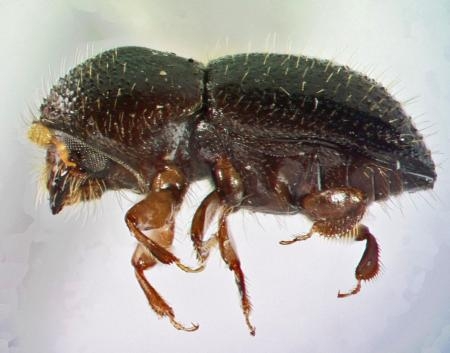Ambrosia beetles comprise a group of over 6,000 species in the Scolytinae subfamily. Most of these beetles typically attack decomposing and dead trees. The Polyphagous/Kuroshio Shot Borers have been reports on over 300 landscape and wildland living tree species, including avocado. Decline and death of trees has been noted in California since 2012, and the full economic extent is still unclear. The beetles feeds on a fungal symbiont that is introduced into the tree, and it is the fungus that spreads throughout the tree and causes the tree decline and death.
What was once thought to be another species of beetle (Tea Shot Hole Borer) and then identified as a new species - Polyphagous Shot Hole Borer- and now expanded to include another species of borer – Kuroshio Shot Hole – is showing that its fungal partners can be quite diverse. A recent publication indicates the increasing tangled association of the shot hole borer/disease complex that is affecting avocado and other tree species.
Two Novel Fungal Symbionts Fusarium kuroshium sp. nov. and Graphium kuroshium sp. nov. of Kuroshio Shot Hole Borer (Euwallacea sp. nr. fornicatus) Cause Fusarium Dieback on Woody Host Species in California
Francis Na, Joseph D. Carrillo, Joey S. Mayorquin, Cedric Ndinga-Muniania, and Jason E. Stajich, Department of Plant Pathology and Microbiology, University of California, Riverside, 92521; Richard Stouthamer, Department of Entomology, University of California, Riverside, 92521; Yin-Tse Huang, Department of Plant Pathology, National Chung Hsing University, Taichung 402, Taiwan, ROC, and School of Forest Resources and Conservation, Institute of Food and Agricultural Sciences, University of Florida, Gainesville; Yu-Ting Lin and Chi-Yu Chen, Department of Plant Pathology, National Chung Hsing University, Taichung 402, Taiwan, ROC; and Akif Eskalen,† Department of Plant Pathology and Microbiology, University of California, Riverside, 92521
https://apsjournals.apsnet.org/doi/abs/10.1094/PDIS-07-17-1042-RE
Shot hole borer (SHB)-Fusarium dieback (FD) is a new pest-disease complex affecting numerous tree species in California and is vectored by two distinct, but related ambrosia beetles (Euwallacea sp. nr. fornicatus) called polyphagous shot hole borer (PSHB) and Kuroshio shot hole borer (KSHB). These pest-disease complexes cause branch dieback and tree mortality on numerous wildland and landscape tree species, as well as agricultural tree species, primarily avocado. The recent discovery of KSHB in California initiated an investigation of fungal symbionts associated with the KSHB vector. Ten isolates of Fusarium sp. and Graphium sp., respectively, were recovered from the mycangia of adult KSHB females captured in three different locations within San Diego County and compared with the known symbiotic fungi of PSHB. Multigene phylogenetic analyses of the internal transcribed spacer region (ITS), translation elongation factor-1 alpha (TEF1-α), and RNA polymerase II subunit (RPB1, RPB2) regions as well as morphological comparisons revealed that two novel fungal associates Fusarium kuroshium sp. nov. and Graphium kuroshium sp. nov. obtained from KSHB were related to, but distinct from the fungal symbionts F. euwallaceae and G. euwallaceae associated with PSHB in California. Pathogenicity tests on healthy, young avocado plants revealed F. kuroshium and G. kuroshium to be pathogenic. Lesion lengths from inoculation of F. kuroshium were found to be significantly shorter compared with those caused by F. euwallaceae, while no difference in symptom severity was detected between Graphium spp. associated with KSHB and PSHB. These findings highlight the pest disease complexes of KSHB-FD and PSHB-FD as distinct, but collective threats adversely impacting woody hosts throughout California.
Attached Images:
